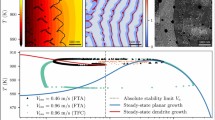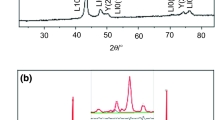Abstract
The compound, UA14, which forms during the peritectic reaction (Liquid + UA13 → UAI4), has a long needlelike shape and reveals the characteristic morphology of a fishtail when cut along the long axis. When cut perpendicular to the long axis, it shows an internal core of another phase, which has been identified as a primary aluminum solid solution. Because of the interesting relationship between the crystallographic structures of UA13 and UA14, the peculiar UA14 morphology can be explained on the basis of a proposed mechanism. The mechanism of UA13 to UA14 transformation has been identified as shear and diffusion controlled transformation.
Similar content being viewed by others
ReferencesReferences
H. P. Leighly and B. L. Bramfitt:Metallography, 1968, pp. 165–93.
H. A. Sailer and R. Rough:A Compilation of U.S. and U.K. Uranium and Thorium Constitutional Diagrams, 1955, BMI-1000.
O. J. C. Runhals and R. R. Boucher:Trans. TMS-AIME, 1965, vol. 233, pp. 1726–32.
B. S. Borie, Jr.:Trans. AIME, 1951, vol. 191, pp. 800–802.
A. R. Kaufman and P. Gordon:Trans. AIME, 1950, vol. 188, pp. 182–94.
B. L. Bramfitt:A Study of Segregation in Cast Aluminum-Umaium Alloys, M.S. Thesis, Department of Metallurgical Engineering, University of Missouri-Rolla, 1962.
Author information
Authors and Affiliations
Additional information
Formerly Graduate Student, University of Missouri-Rolla
Rights and permissions
About this article
Cite this article
Lee, L.P., Leighly, H.P. Mechanism of UAI3 to UAI4 transformation. Metall Trans A 6, 135–139 (1975). https://doi.org/10.1007/BF02673681
Received:
Issue Date:
DOI: https://doi.org/10.1007/BF02673681




